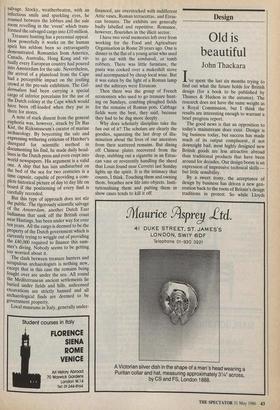Design
Old is beautiful
John Thackara
I've spent the last six months trying to find out what the future holds for British design (for a book to be published by Thames & Hudson in the autumn). The research does not have the same weight as a Royal Commission, but I think the results are interesting enough to warrant a brief progress report.
The good news is that an opposition to today's mainstream does exist. Design is big business today, but success has made much of its output complacent, if not downright bad; most highly designed new British goods are less attractive abroad than traditional products that have been around for decades. Our design boom is an expression of impressive technical skills but little sensibility.
By a sweet irony, the acceptance of design by business has driven a new gen- eration back to the roots of Britain's design traditions in protest. So while Lloyds chooses for its new HQ a High Tech temple, and British Home Stores prepares a Turn To Design for its salvation, tomor- row's generation may be found amid piles of debris, living with furniture made of rusty iron girders. Rather than use design to paper over the cracks of modern life, they seem intent on opening them up, making them a stage set on which the dramas of post-industrial life can be played out.
Much of this so-called 'salvage' design is pretentious; and it goes without saying that it is often uncomfortable. But as an indica- tion that designers are reacting against the all-perfect blueprint approach to buildings, design worked out in splendid isolation from builder, users, and site, it is welcome.
If making environments neat and tidy is anathema to the new design, making pro- ducts super-efficiently is equally unattrac- tive. There is renewed interest in natural materials and hand finishing, features like- ly to alienate most of Britain's cost- obsessed manufacturers. Some of this work takes the form. of furniture made from large lumps of timber, a style boosted by the film sets seen in Derek Jarman's Caravaggio. Other designers are ex- perimenting with advanced high technolo- gy materials made attractive by manual decoration. Their aim is to exploit the functional benefits of technology, while avoiding anything that suggests a 'machine style'. If one has any reservation it is that much of this work is remorseless and austere; even when it is motivated by Wendy Hamburger bars and Mickey Mouse telephones, there seems to be little inclination to levity.
Modern design seems equally unable to cope gracefully with the competition pro- vided by the past. Nobody used to take Barbours, brogues, and shaving brushes seriously, but because these undesigned relics seem to have the best image of all British products abroad, there is now a resurgence of chintz, heraldry and gilt in everything from jewellery to doorknobs. It would be nice to think some of these references were ironic, but one suspects that even the innovators in Britain are milking the imperial heritage one last time. Mind you, it does sell: the Japanese are just wild about Anglo-gothic chic, if the success of the Metropole restaurant in Tokyo, designed by enfant terrible Nigel Coates, is any indication.
Sadly for the rag trade, British street style may sell sushi, but it will no longer sell frocks. The world's fashion buyers and editors, those lemmings in little black dresses, have dumped our new-wave de- signers like so many containerloads of bell-bottomed trousers. This is a shame; fashion has been one area of life in which the British have been light-hearted about their bodies, (not to mention design). The fact that glitz-crazed Americans cannot bring themselves to wear John Galliano clothes (he's the one with the upside down jackets) is grounds, surely, for celebration, even if the economic consequences are uncomfortable. Fashion has resisted con- formity and vacuity; it is a latter-day equivalent of Erlebniskunst, the 'art of experience', which stands against market- led, number-crunched design solutions that end up giving so little real pleasure.
Undesign may well be the significant contribution of today's emerging avant- garde. Architects have learned, begrudg- ingly, to leave well alone when confronted with built forms that have evolved over centuries; is it too much to hope that other designers will follow suit? Refusing to cover everything in attractive but mislead- ing packaging is a first step: the next should be to acknowledge the attractions and qualities of those products and experiences that do not need 'improving', and to devote technical and design skills to their maintenance. One simple example is food shops. Marks & Spencer have proved that it is possible to provide the kind of food people encounter on holiday in France and Italy, at a reasonable price; is it beyond their ken now to recreate the ambience that makes the buying of food in those countries such a pleasure? This a matter not of bolt-on plastic garlics, but of space planning, lighting design, high-quality shelving and tiles, and staff motivated to take as much pleasure in display as their counterparts in Florence or Aix en Provence.
It all boils down to designers learning about the sense of use in products and services — in the same way that architects have had to re-learn a sense of place. If this means a certain loss of professional auton- omy, for example in admitting that an Italian grocer may know more about retail design than the specialist, then that price will have to be paid.



























































 Previous page
Previous page